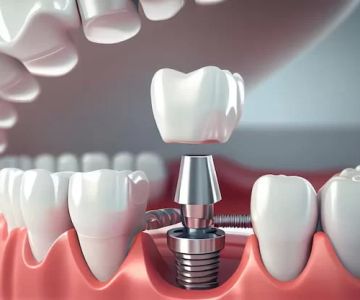How to Restore a Smile After Tooth Loss: Best Options for a Beautiful Smile
- 1. Why Tooth Restoration is Important for Your Smile
- 2. Different Options for Restoring a Smile After Tooth Loss
- 3. Benefits of Dental Implants for Tooth Restoration
- 4. Real-Life Stories of Restoring a Smile After Tooth Loss
- 5. How to Get Started with Restoring Your Smile
1. Why Tooth Restoration is Important for Your Smile
Tooth loss can have a significant impact on both your appearance and confidence. Whether it's due to injury, decay, or natural aging, losing a tooth or multiple teeth can cause you to feel self-conscious about your smile. However, with modern dental treatments, restoring your smile is easier than ever before.
Not only does restoring a missing tooth improve the appearance of your smile, but it also helps with overall oral health. Missing teeth can cause issues with chewing, speaking, and alignment of the remaining teeth, leading to further complications down the line. Tooth restoration is not just about aesthetics; it’s also about restoring functionality and boosting your self-esteem.
2. Different Options for Restoring a Smile After Tooth Loss
There are several options available for restoring a smile after tooth loss, and the best solution depends on your unique needs, the number of teeth missing, and your overall oral health. Let’s explore the most common options:
- Dental Implants: Dental implants are often considered the gold standard for tooth restoration. They are titanium posts that are surgically placed into the jawbone and topped with a crown. Dental implants provide a permanent and natural-looking solution to replace missing teeth. They help maintain the integrity of your jawbone, preventing bone loss, and they function just like your natural teeth.
- Bridges: Dental bridges are used when one or more teeth are missing. They consist of a false tooth anchored to the adjacent natural teeth, filling the gap left by a missing tooth. Bridges are a good option for people who may not be suitable candidates for implants and want a more affordable solution.
- Dentures: Dentures are removable appliances designed to replace missing teeth. They are typically used when a person has lost multiple teeth. Dentures can be partial (for a few missing teeth) or full (for replacing all teeth in the upper or lower jaw). While dentures may not provide the same level of comfort and stability as implants, they are an effective option for many people.
- Resin-Bonded Bridges (Maryland Bridges): Resin-bonded bridges are a less invasive option compared to traditional bridges. These are usually used for front teeth and involve attaching a false tooth to the existing teeth with a metal or porcelain framework. This is a more affordable and less invasive option but may not be as durable as dental implants.
3. Benefits of Dental Implants for Tooth Restoration
Dental implants are the most advanced and effective option for restoring a smile after tooth loss. Here are some of the key benefits of choosing dental implants:
- Permanent Solution: Unlike dentures or bridges, dental implants are a permanent solution. They are securely attached to the jawbone and do not require removal or adjustment over time.
- Natural Appearance: Implants look and feel just like natural teeth. The crown placed on top of the implant is designed to match the color and shape of your existing teeth, providing a seamless appearance.
- Improved Oral Health: Dental implants help preserve the health of your jawbone by stimulating it, which prevents bone loss that often occurs when a tooth is lost.
- Enhanced Comfort: Because dental implants are integrated into the bone, they provide greater stability and comfort compared to removable dentures. You won’t have to worry about slipping or discomfort when eating or speaking.
- Increased Confidence: Restoring your smile with dental implants can have a dramatic impact on your self-esteem. You can smile with confidence knowing that your teeth look natural and functional.
4. Real-Life Stories of Restoring a Smile After Tooth Loss
Many people have experienced life-changing results after restoring their smile following tooth loss. Here are a few real-life examples:
- Case 1: Sarah, a 45-year-old woman from Los Angeles, had been dealing with a missing tooth for several years after an accident. She chose dental implants and was thrilled with the results. “The implants look and feel just like my real teeth,” Sarah says. “I can finally smile confidently again and eat without worrying about my teeth.”
- Case 2: John, a 60-year-old man, had been wearing dentures for years but found them uncomfortable and inconvenient. After opting for dental implants, he says, “The difference is incredible. I feel like I’ve gotten my life back. I no longer have to worry about my dentures slipping or the discomfort of them. I’m so happy with the outcome!”
5. How to Get Started with Restoring Your Smile
If you’re considering restoring your smile after tooth loss, the first step is to consult with a qualified dentist or oral surgeon. They will assess your oral health, discuss your options, and create a personalized treatment plan that suits your needs.
Here’s how you can get started:
- Schedule a Consultation: Reach out to a dentist who specializes in restorative dentistry. During your consultation, they will evaluate your oral health and discuss the best options for tooth restoration.
- Ask Questions: Don’t hesitate to ask about the different treatment options, costs, recovery times, and any other concerns you may have.
- Review Financing Options: Some dental procedures, especially implants, can be expensive. Be sure to inquire about payment plans or financing options available to help make the treatment more affordable.
- Follow the Treatment Plan: Once you’ve chosen your treatment plan, follow your dentist’s instructions to ensure the best results. This may include follow-up visits to monitor your progress and any additional treatments if needed.
If you’re ready to restore your smile and regain your confidence, visit Dentistry Toothtruth for more information about the best tooth restoration options available to you. Our team is here to help you achieve the smile you’ve always wanted.







 Forbes Dental Care5.0 (11 review)
Forbes Dental Care5.0 (11 review) Smiles Divine Dental4.0 (25 review)
Smiles Divine Dental4.0 (25 review) DR. MICHAEL H. MCMILLAN5.0 (3 review)
DR. MICHAEL H. MCMILLAN5.0 (3 review) HOLISTIC DENTAL AND WELLNESS CENTER3.0 (8 review)
HOLISTIC DENTAL AND WELLNESS CENTER3.0 (8 review) Advanced Family Dental & Orthodontics4.0 (130 review)
Advanced Family Dental & Orthodontics4.0 (130 review) Hawthorn Woods Family Dental Care5.0 (535 review)
Hawthorn Woods Family Dental Care5.0 (535 review) The Importance of Oral Health Education During Pregnancy for a Healthy Pregnancy
The Importance of Oral Health Education During Pregnancy for a Healthy Pregnancy Best Tips for Brushing Your Teeth Properly for Healthy Gums: Essential Techniques for Oral Health
Best Tips for Brushing Your Teeth Properly for Healthy Gums: Essential Techniques for Oral Health Why Skipping Dental Checkups Can Lead to Bigger Oral Health Problems
Why Skipping Dental Checkups Can Lead to Bigger Oral Health Problems Advantages of Porcelain Dental Restorations
Advantages of Porcelain Dental Restorations How Can Diabetes Cause Tooth and Gum Problems? Preventing and Managing Oral Health Issues
How Can Diabetes Cause Tooth and Gum Problems? Preventing and Managing Oral Health Issues Healthy Habits for Promoting Good Oral Health and Hygiene: Tips for a Healthy Smile
Healthy Habits for Promoting Good Oral Health and Hygiene: Tips for a Healthy Smile